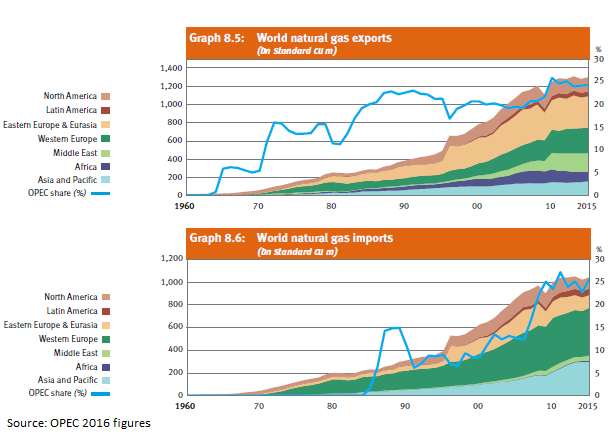Cairo – Decypha: While mostly synonymous with oil, the Middle East has a wealth of natural gas reserves, representing up to 40% of the world’s reserves, yet only around 10% of global production comes from the region.
Natural gas prices have also been on shaky grounds, according to data by British Petroleum (BP), yet it holds the position of the most traded commodity globally after oil. Additionally, the World Energy Outlook, projects that by 2035 the contribution of natural gas to the global energy mix will rise from its current standing of 21% to 25% by 2035.
Reserves
In terms of reserves, total reserves for the Organization of the Petroleum Exporting Countries (OPEC) is estimated at 97,510 billion cubic meters (bcm), according to OPEC 2016 report. The Middle East specifically, stands at 79,430 bcm, which is 0.8% less than the previous year.
The highest contributor, in terms of OPEC members, is Iran at 33,500 bcm in reserves, followed by Qatar at 24,300 bcm. Most other members fall significantly behind in terms of natural gas reserves.
While Egypt is leading the region’s non-OPEC members in terms of natural gas reserves, the Egyptian government has stopped announcing officially the exact figure since 2014. The country is still ranked 17th globally, and is believed to have around 2,168 bcm.
Global reserves stand at 202 bcm, where OPEC members contribute the lion’s share with 48.26%, and the Middle East as a region contributes around 39.25%.

Production
In terms of production, OPEC members produce collectively 828,916 million cubic meters (mcm), with Iran and Qatar representing half of the total natural gas production levels.
Iran produces 226,673 mcm, representing 27.3% of total production, while Qatar comes next, representing 21.5% of total production, with 178,472 mcm.
Saud Arabia comes next with 104,450 mcm, while the United Arab Emirates’ (UAE) production hits only 60,181 mcm.
Global production stands at 3.644 trillion cubic meters, of which OPEC members represent 22.7%, and the Middle East as a region represents, 18%.

Consumption
The Middle East consumes a total of 472,104 mcm, while OPEC countries have a consumption level is estimated at 549,451 mcm, representing 15.7% of global consumption.
It is worth noting that global natural gas consumption has seen a reduction of 3.3% according to OPEC’s latest figures.
Exports
The latest OPEC figures, put the total export volume of member countries at 255,671 mcm. Qatar, single handedly, represents 51% of total export volume by OPEC members, producing more than 129,000 mcm, followed by Algeria which only represents 17% of total production at 43, 418 mcm. For UAE, the country exports a total of 13,200 mcm, while Iran reportedly exports around 8,541 mcm.
It is worth noting that Saudi Arabia, Kuwait, and Iraq do not export natural gas, according to OPEC 2016 report.

Future outlook
Despite a global move towards green energy, demand for natural gas is expected to continue to grow in the coming period, especially as electricity projects specifically in the MENA region are on the rise. Morocco, Tunisia, and Lebanon for example are looking into establishing liquefied natural gas (LNG) import units, according to BMI Research. While Bahrain is installing its first Floating Storage Regasification Unit (FSRU) by 2018.
By Decypha Editorial Team.

